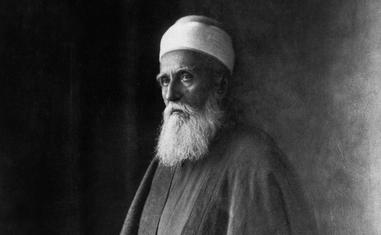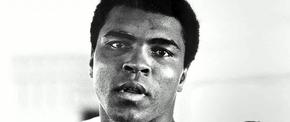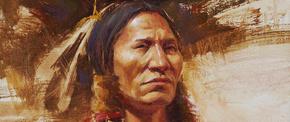The views expressed in our content reflect individual perspectives and do not represent the authoritative views of the Baha'i Faith.
All Baha’is share a role model in Abdu’l-Baha, the son who led the Faith after his father Baha’u’llah’s passing – and the true example of what it means to be a Baha’i and to act as one for a lifetime.
In mid-May 2021, while preparing for the launch of the Tablet of Visitation for Thomas Breakwell with Adib Masumian as a part of the Centenary of the Ascension of Abdu’l-Baha collection on The Utterance Project, I started to visualize the astonishing arc of Abdu’l-Baha’s life – that unprecedented figure in religious history the Guardian of the Baha’i Faith, Shoghi Effendi, called “the perfect Exemplar of [Baha’u’llah’s] teachings” and “the embodiment of every Baha’i ideal, the incarnation of every Baha’i virtue …”
RELATED: Abdu’l-Baha: From Prisoner to Honored Guest
The more I read about Thomas Breakwell, the first Englishman to become a Baha’i, a sketch of his life as a series of significant moments relating to Abdu’l-Baha began to draw itself in my mind – and become the catalyst for “The Extraordinary Life of Abdu’l-Baha,” a new chronology of his life in honor of the centenary of his passing.
The Extraordinary Life of Abdu’l-Baha is not an academic work or a mere timeline – instead, it is a storytelling chronology of the life and times of the remarkable man who led the world’s newest major Faith and exemplified its peaceful and compassionate teachings.
Created for Immersion
Initially I realized that I had to make the chronology vast, so it could reveal a glimmer of Abdu’l-Baha’s immense, majestic life.
The numerous stories it contains are drawn from over two hundred biographies, memoirs, compilations, online and scholarly articles, and manuscript diaries, and include stories that will be new to most readers. Because the chronology is substantial and written in the present tense, illustrated with over 800 photos and 100 maps and specially-designed graphics, it provides the reader with an experience of immersion in the life of Abdu’l-Baha. Hopefully, it offers a glimpse of the reasons why millions of Baha’is, from every creed, continent, and culture, see Abdu’l-Baha as a role model for their own lives.
Structure and Design
The chronology is divided into nine thematic parts, each addressing a key period in the life of Abdu’l-Baha. Each part is divided into sections, color-coded by location. The Holy Day Baha’is will observe on November 27 – the Ascension of Abdu’l-Baha – comprises a full part unto itself, in honor of the Centenary of his passing in 1921.
The Photographs
The multitude of photographs in the chronology are intended to create a visual bond between the reader and the life of Abdu’l-Baha. Each time he goes to a new place, steps onto another steamer, visits a new site, meets a prince or an artist, or speaks at a venue, a photograph connects the reader to that event or person, illustrating as many stories as possible. You’ll see a photograph of thorn-pickers, like the one Abdu’l-Baha met as a youth in Baghdad; see his name on the Cedric ship manifest at Ellis Island; and even look at pictures of the locust plague of 1915 that ravaged the crops in the Middle East.
The photos in Part IX: The Ascension of Abdu’l-Baha represent a contribution by the dedicated staff of the National Baha’i Archives of the United States. Two of the last photographs ever taken of Abdu’l-Baha are in this section, including one that shows him carrying a dear friend’s casket on his shoulders. You’ll also see dozens of high-resolution photos of Abdu’l-Baha’s massive funeral, showing Boy Scouts guiding the cortège. There is also a photo of the poor of Haifa and Akka receiving sacks of wheat on the seventh day after Abdu’l-Baha’s passing.
Handmade Maps and Graphics
The specially-designed maps and graphics in The Extraordinary Life of Abdu’l-Baha exist to deepen the understanding of his unprecedented life with visually-compelling elements. Each exile is mapped, as are the cities of Haifa and Akka, the Baha’i gardens in the Akka area, his journeys to the West, the Jordan River valley, and the route of his funeral cortège. Graphics summarize complex amounts of information, so because I wanted to give the readers a sense of Abdu’l-Baha’s three-year herculean undertaking when he traveled to the West, I collaborated with Baha’i authors Earl Redman and Amín Egea to produce an infographic that shows the estimated audience attendance and media reach for those journeys at the very end of Part VII. There are a number of such graphics throughout the chronology.
RELATED: The Centenary of Abdu’l-Baha’s Ascension: A Fragrant Trail
Interactive Links
Readers can follow links to learn more about certain people and events, download articles to pursue a topic in more depth, or read over a hundred newspaper stories about Abdu’l-Baha. Some content is offered in several different formats. In addition to selected stories about Abdu’l-Baha’s sojourn in the West in Parts V, VI, and VII, there is a date-place-and-talk version of that three-year journey available as a simplified timeline. This timeline, at the bottom of parts V, VI, and VII, contains links to every available talk Abdu’l-Baha gave during those three years. The journeys are also offered in the form of a summary map, an infographic totaling every individual stay in each of the seven countries Abdu’l-Baha visited, or a Google Map, showing all of Abdu’l-Baha’s movement in that historic three-year period.
What I Learned
One of the most important lessons I learned in the process of writing The Extraordinary Life of Abdu’l-Baha is the value of collaboration. Many eminent Baha’i historians have suggested stories, sent me photographs, allowed me to quote unpublished manuscripts, provided references, offered mentorship, and collaborated on sections.
During the process, the sheer number of things I learned about Abdu’l-Baha profoundly affected me. My favorite part of the entire experience was discovering his life in the Holy Land. There was so much that I had never heard about, and the stories were exciting, full of details, and surprising. I now have a more precise understanding of Abdu’l-Baha’s complex decades in the Holy Land, a mental map of most of the places he set foot in, and so many stories of interesting people he met along the way. I hope everyone who reads this can have that same moving experience.
For their collaborative assistance and inspiration I want to thank Earl Redman, Michael V. Day, Amín Egea, Jan Jasion, Necati Alkan, Adib Masumian, Christopher Buck, Youli Ioannesyan, Ismael Velasco, Nabil Khodad, Ágnes Ambró, Alexander Meinhard, Steven Kolins, Charleen Maghzi-Ader, and Kurt Asplund.

















Comments
Sign in or create an account
Continue with Facebookor